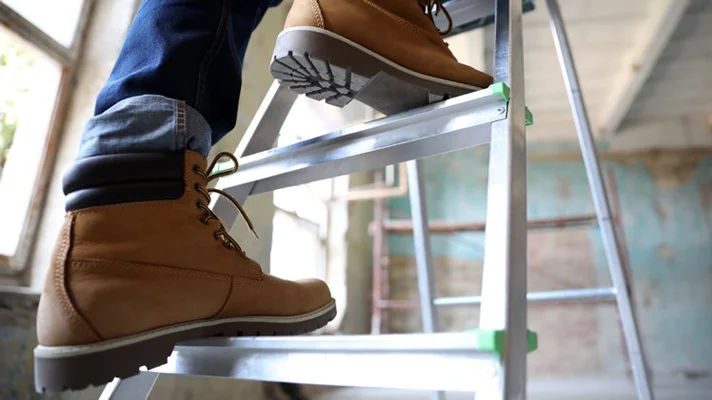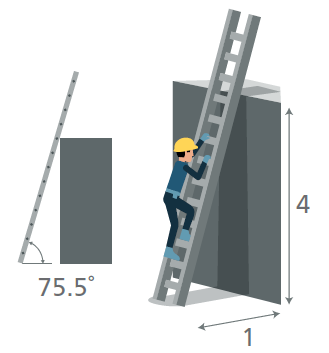Secure your future today!
Ladder Safety

According to the Centers for Disease Control, hundreds of injuries and fatalities occur annually from ladder related accidents.” Every ladder accident poses the risk for a severe injury or even fatality.
Improper use of a ladder can lead to injuries or more severe harm from falls and slips. A person climbing a ladder may reach too far or make a misstep, or the ladder may be broken or not set up properly.
Ladder Selection
There are three basic portable ladder types:
- Type I - Heavy-duty industrial with a load capacity not exceeding 250 pounds
- Type II - Medium-duty commercial with a load capacity not exceeding 225 pounds for the task and the user.
- Type III - Light-duty household with a load capacity not exceeding 200 pounds Remember, load capacity is the combined weight of the individual and the items that the individual is carrying. Choose the right ladder for the task and the user.
Precautions for Safe Ladder Use
Inspect the ladder for defects prior to use.
- Select a ladder with adequate length and load limits.
- Do not use metal ladders near electrical lines.
- Use ladders for their intended purpose only.
- Use the correct angle, supports, treads, cross braces, and rails.
- Do not overload.
- Use barricades to keep activities or traffic away from ladders.
- Keep areas around the top and bottom of the ladder clear.
- Open stepladders fully and lock the spreaders.
- Set up straight ladders using the 4-to-1 rule: For every 4 feet up, place the base of the ladder 1 foot away from the wall.
- Face ladders when ascending/descending.
- Use both hands to grip the side rails whenever possible. You should always have three points of contact when climbing or descending a ladder.
- Only one person on a ladder at a time.
- Do not stand on the top two steps of a stepladder.
- Never move a portable ladder while someone is using the ladder.
- Do not use the cross bracing on the rear of a stepladder for climbing.
- Hoist material up to you when you’ve reached the top of the ladder.
- Work within the side rails.

4 to 1 Rule
Make sure you can set up your ladder at the required angle, using the 4-to-1 Rule:
For every 4 feet (1.2 meters) up, place the base of your ladder 1 foot (0.3 meters) from the wall or upper support that it rests against.
Maintenance
- Store ladders in designated areas.
- Make sure ladders are easy to access and inspect.
- Remove ladders with structural defects, corrosion, or defective parts from service and tag “Do Not Use.”
- Have qualified personnel make repairs to meet the ladder’s original design.
Ladder Transport
- Lift ladder using leg muscles, not back muscles, and carry close to body.
- Balance center of ladder on your shoulder.
- Position so front end of ladder is above your head and back end is near the ground.
- Set ladder down when opening and closing doors.
- Take special care when ascending and descending stairs, negotiating corners, or turning around.
- When it is necessary for two people to carry a ladder, both should be on the same side of ladder and both people should walk in step.
- Spikes, hooks, or ladder feet should face toward the rear when ladder is being carried.
Training
- An experienced professional must train each employee in proper construction, use, placement and care in handling of ladders, maximum intended load carrying capabilities of ladders, and proper inspection techniques.
Download This Article
Additional Safety Topics
Check Out All Our Products
Commercial Insurance Built for You
We offer a wide range of Commercial insurance products. Find the product that's right for you!
Specialty Insurance
Commercial Auto Insurance Workers' Compensation Insurance Manufacturing Insurance Insurance for WineriesConstruction and Contracting
General Contractor Insurance Carpenters Insurance Plumbing Insurance Excavator Insurance Electrician Insurance HVAC Business Insurance Lawn Care Business InsuranceRetail and Service
Retail Business Insurance Barber Insurance Pet Grooming Insurance Florist Insurance Bakery Insurance Photographer Insurance Beautician Insurance Coffee Shop Insurance Funeral Home Insurance Janitorial InsuranceGet Insurance for Your Car and Home
You need to protect more than just your business. Get insurance for your personal property too!
Personal Lines InsuranceWe've Got You Covered!
We offer Personal Lines Insurance in five states: Ohio, Michigan, Illinois, Indiana, and Wisconsin.
Insurance for All Types of Farms
Hastings offers a range of products specifically designed for farmers.
Farm InsuranceWe've Got You Covered!
We offer Farm Lines Insurance in five states: Ohio, Michigan, Illinois, Indiana, and Wisconsin.
Secure your future today!
Hastings Insurance Company
404 E. Woodlawn Ave.
Hastings, MI 49058
Monday-Friday
8:00 a.m. - 4:30 p.m. (EST)
(800) 442-8277
Terms of Use and Privacy Statement© Hastings Insurance Company. All rights reserved.



